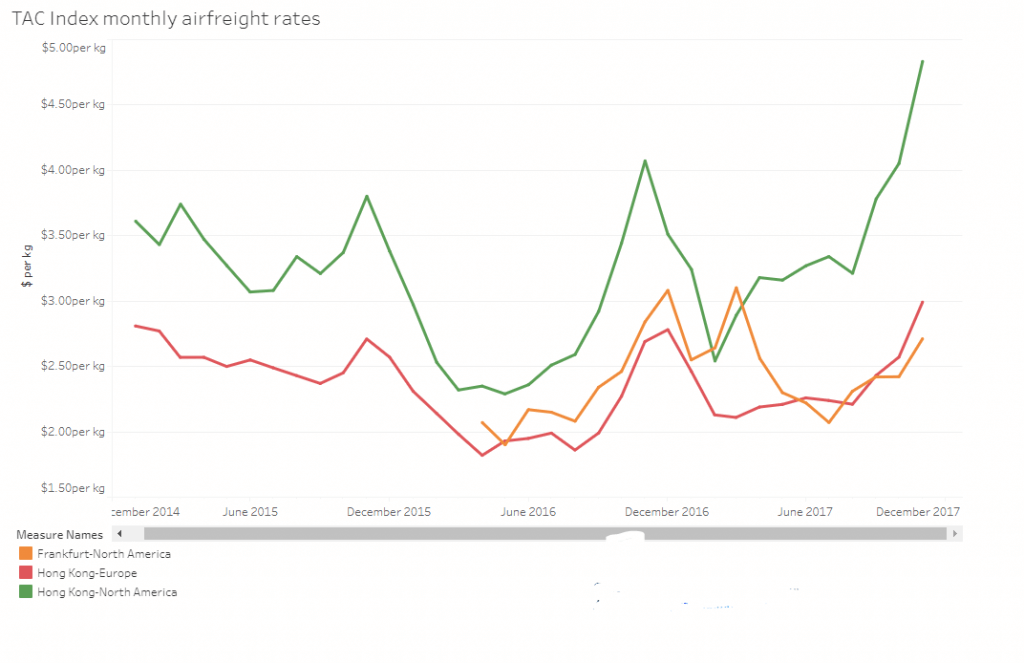
The market is reporting incredibly high air cargo rates as demand overtakes available supply out of Europe, leading to chronic space constraints on aircraft and causing congestion and delays at air cargo hubs struggling to handle the record volume.
Shippers trying to shift products to market before the holidays are being further frustrated by waves of severe winter storms that have been sweeping across the United Kingdom and Northern Europe for the past 10 days, leading to widespread flight disruption at hubs such as Heathrow, Frankfurt, Zurich, and Amsterdam.
The logistics manager of a global electronics group based in Europe said air freight prices have been rising for the last two months, especially on lanes out of Europe to the United States and Asia, and also on Asia-Europe routes, with US-Europe the only trade lane unaffected.

But he said air freight pricing had taken a disturbing turn. “We see a dramatic change in freighter operators behavior — whoever pays more will get the space. This can increase the price per kilogram sometimes even by 10 times,” he said. “Luckily we have contracts in place with forwarders and this can mitigate some of the negative trends in our spendings.”
Manel Galindo, CEO of Freightos WebCargo, said the high demand-tight supply nature of the business meant the auction-like market behavior would continue, and he gave some other startling examples of the high prices being paid as space dries up.
“I’ve seen forwarders paying more than 18 euros per kilogram [more than $20/kilogram] for Europe to South America, and even one offer around 30 euros per kilogram. These prices aren’t realistic — or at least they shouldn’t be,” he said.
Galindo said with the exception of pharmaceutical and tech products, which have enough margin to absorb high air freight costs, the significantly higher rates this year would have many shippers reviewing their mode mix and looking to ocean next year. But for about half of the shippers that use air cargo, it is an emergency option and not one of choice, so the space constraints and backlogs come at a time when there is no room for additional delays. The impact of excessive demand is being felt across major European airports and airlines. A Lufthansa Cargo spokesperson said that flights to every destination from major German airports were full.
“Especially our flights to North America including Mexico are showing extremely high demand and in consequence very high load factors. But also our flights to Asia and the rest of the world are full for weeks and we expect this to continue for some time,” the spokesperson said.
Unfortunately, airlines are not expecting congestion to abate and prices to return to normal until Jan. 15, just in time to start heating up again as shipments compete to get out of airports before the Chinese New Year shutdown, Galindo said.
Slots at Europe’s hub airports are already almost full, and rapidly rising passenger and cargo demand could see hundreds of airports reaching capacity in the next 10 years, threatening widespread disruption of supply chains at a time when soaring e-commerce is expected to fill planes well into the future.
Airbus and Boeing predict the number of aircraft in service will more than double in the next 20 years, and the International Air Transport Association (IATA) said airlines across the world connected a record number of cities this year, with more than 20,000 city-pair connections, an increase of 1,351 compared with 2016.
Although the vast majority of the demand is in the passenger sector, the implications for air cargo are enormous as airport capacity will fall short of the airport access required, according to Lara Maughan, IATA head of worldwide airport slots.
www.joc.com
“Disclaimer: “Breakbulk News & Media BV (Breakbulk.News) assumes no responsibility or liability for any errors or omissions in the content of articles published. The information and or article contained in these articles is provided on an “as is” basis with no guarantees of completeness, accuracy, usefulness or timeliness…”

